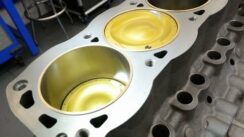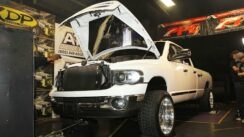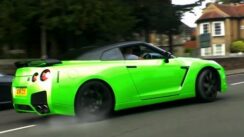Drag Racing 101: How to Drag Race

Ever wanted to go drag racing, but don’t know how to get started? You’re in luck friend, as we recently hit up our local quarter mile drag strip to check out the action and get some advice from several people that have been doing it for years. Take the jitters out of your first run, with our complete guide to your first time at the drag strip!
Newb:
So, what is drag racing anyway?
HorsepowerSpecs:
In the simplest terms, it’s a sport where two drivers compete in an acceleration contest over a straight quarter-mile track. The National Hot Rod Association and the International Hot Rod association are the two main sanctioning bodies in North America, and almost all drag strips are associated with one or the other, and run multiple races each year in different classes. The races are brief, but intense. Starting at the same time at the starting line, each driver tries to get to the finish line first. The one that does is declared the winner.
Newb:
Oh, I’ve done this in Need For Speed.
HorsepowerSpecs:
Err, except that’s a video game. This is reality where you don’t have an indestructible Koenigsegg. Instead, you can drive whatever you have available, whether that’s a Mustang GT or Corolla S. You’ll get to stomp on the throttle and test your vehicle’s maximum acceleration, and due to the quickness of each race, you’ll get to make several passes each night.
Newb:
That sounds fun. Where can I drag race?
HorsepowerSpecs:
Google is your friend here. “NHRA track locator” will get you to the right page, or just search “drag strip (your city)” although the results might be off if you don’t have a track within an hour’s drive. If you live someplace crappy, you might have to suffer through an eighth-mile track.
Newb:
What, like Eminem?
HorsepowerSpecs:
Eighth-mile, not Eight Mile. Half of a quarter-mile track. While not a fast drag strip experience, the shorter track does provide the benefit of lower top speeds, and thus, improved safety.
Newb:
So, yeah, what about safety?
HorsepowerSpecs:
Unfortunately, people do die while drag racing.
Newb:
What?!
HorsepowerSpecs:
However, that is usually at the very top end of the sport, driving 10,000 horsepower mega-buck race cars at 300 mph. Your Corolla barely has enough power to get out of its own way, and is statistically safer on a dragstrip than on the street due to the closed environment. It’s just you and one other vehicle, with both drivers paying attention and surrounded by safety gear and crew. The street is much more dynamic, unpredictable, and busy, so if you can drive out in public with all the Pokémon GO driver/players, you’ll feel quite at ease on the strip.
Newb:
Got it. Do I need a special license for this?
HorsepowerSpecs:
Nope, but you do need a valid driver’s license, so I’m going to assume you have one of those. Bring it with you (obviously), as well as your proof of insurance.
Newb:
Alright, but how much does it cost? Seems like racing would be expensive.
HorsepowerSpecs:
Drag racing during a “test and tune” session is incredibly cheap. We’re talking as low as $15 for as much racing as you can pack into a night. On slower nights, when there are fewer cars and more passes per driver, your costs could be under $1.50 each pass. Compare that to an open track day on a road course, where you’re paying a few hundred bucks, plus eating up expensive tires. This is a steal.
Newb:
That’s not bad at all. Will my daily driver ’83 Toyota Corolla be accepted?
HorsepowerSpecs:
Sure, as long as it passes tech inspection.
Newb:
What does that involve?
HorsepowerSpecs:
For certain classes, they are mainly making sure you have the required safety equipment. For a daily driver, they are making sure that your vehicle is as reasonably safe as it can get. Stuff like not having junk in the back seats, rust holes in the chassis, cords poking through the tread, and such. If you can pass a state safety inspection, and have cleaned out all your McDonald’s wrappers, you should be set.
Newb:
I’ve heard of people causing damage to their rides, like grenading the rear end, or the engine catching fire. Can drag racing cause any damage to my vehicle?
HorsepowerSpecs:
You’ll only blow up the rear end if you’re running a 10-bolt in an F-body, and the only way to blow the welds on the intake is to star in a Fast & Furious movie. Drag racing is the same amount of wear and tear as when you accelerate onto a highway, or gas it to pass an 18-wheeler. It is outside normal operation, but it’s also something the vehicle was designed for, even if only in brief stints. Still, that’s exactly what a drag race is: brief. You’re looking at a maximum of 20 seconds until the race is over, and if your ride can’t handle that, then you likely won’t pass tech.
Newb:
Okay, enough about the car. What about me? Anything I should know for a first trip?
HorsepowerSpecs:
Show up early. Just because test and tune starts at 6, that doesn’t mean be like your girlfriend and fashionably late at 8. Before the runs, it’s like a mechanic’s car show, with all the badass old iron on display, receiving their final tuning touches. Walk around, take pics, talk to people, learn something. Plus, after tech inspection, you’ll have to sign various release forms that you won’t read.
Newb:
Already forgotten. What else?
HorsepowerSpecs:
Keep your street tires out of the water box. That’s just before the staging area where the guys on slicks are doing burnouts. Slicks like to be cleaned and heated like that. Your 185 wide touring sedan tires don’t enjoy burnouts, so drive around the water box to the staging lanes.
Newb:
And then just stop when the light turns red, like a stoplight?
HorsepowerSpecs:
Sort of. Ease up slowly towards the “Christmas tree,” the staging lights. The director might be waving you forward, but go slow your first time. When the nose of your ride breaks the first invisible staging beam, the top bulb will light. This is pre-stage. Etiquette says to wait for the other racer to pre-stage, then once you are ready to rock, ease forward until you see the second full-stage light. This lets the director know you are ready. Then it’s a quick series of sequential amber lights to the big green. Best bet is to gas it on the last amber, as your reaction time will be horrible if you wait for the green light.
Newb:
Hey, what if I lose?
HorsepowerSpecs:
Dude, you’re going to lose. It’s your first time out and you will likely end up running against someone that has a lot of experience, and/or a much faster car. The great thing about test and tune nights is that there are no winners or losers. Completely ignore the other guy. You are competing against the clock, yourself, and your best time.
If you’re ready to hit the track this weekend for your first time at the drag strip, be sure to come back and let us know how it went. Alternatively, if you’re a pro, feel free to add any sage advice in the comments below.

































































































































